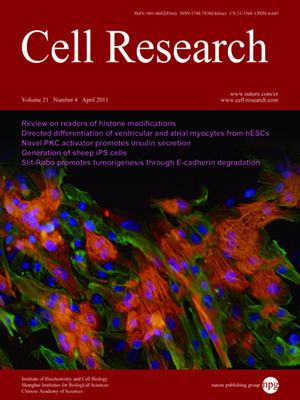
Volume 21, No 4, Apr 2011
ISSN: 1001-0602
EISSN: 1748-7838 2018
impact factor 17.848*
(Clarivate Analytics, 2019)
Volume 21 Issue 4, April 2011: 579-587
ORIGINAL ARTICLES
Direct differentiation of atrial and ventricular myocytes from human embryonic stem cells by alternating retinoid signals
Qiangzhe Zhang1,*, Junjie Jiang1,*, Pengcheng Han1,*, Qi Yuan1, Jing Zhang1, Xiaoqian Zhang1, Yanyan Xu1, Henghua Cao1, Qingzhang Meng1, Li Chen1, Tian Tian1, Xin Wang2, Pu Li1, Jurgen Hescheler3, Guangju Ji1 and Yue Ma1
1National Laboratory of Biomacromolecules, Institute of Biophysics, Chinese Academy of Sciences, 15 Datun Rd., Chaoyang District, Beijing 100101, China
2Institute of Biochemistry and Cell Biology, Shanghai Institutes of Biological Sciences, 320 Yueyang Rd., Shanghai 200032, China
3Center for Physiology and Pathophysiology, Institute for Neurophysiology, University of Cologne, Robert-Koch-Str. 39, 50931 Cologne, Germany
Correspondence: Yue Maa, Guangju Jib,(yuema@ibp.ac.cn; gj28@ibp.ac.cn)
Although myocyte cell transplantation studies have suggested a promising therapeutic potential for myocardial infarction, a major obstacle to the development of clinical therapies for myocardial repair is the difficulties associated with obtaining relatively homogeneous ventricular myocytes for transplantation. Human embryonic stem cells (hESCs) are a promising source of cardiomyocytes. Here we report that retinoid signaling regulates the fate specification of atrial versus ventricular myocytes during cardiac differentiation of hESCs. We found that both Noggin and the pan-retinoic acid receptor antagonist BMS-189453 (RAi) significantly increased the cardiac differentiation efficiency of hESCs. To investigate retinoid functions, we compared Noggin+RAi-treated cultures with Noggin+RA-treated cultures. Our results showed that the expression levels of the ventricular-specific gene
IRX-4 were radically elevated in Noggin+RAi-treated cultures. MLC-2V, another ventricular-specific marker, was expressed in the majority of the cardiomyocytes in Noggin+RAi-treated cultures, but not in the cardiomyocytes of Noggin+RA-treated cultures. Flow cytometry analysis and electrophysiological studies indicated that with 64.7±0.88% (mean ±s.e.m) cardiac differentiation efficiency, 83% of the cardiomyocytes in Noggin+RAi-treated cultures had embryonic ventricular-like action potentials (APs). With 50.7±1.76% cardiac differentiation efficiency, 94% of the cardiomyocytes in Noggin+RA-treated cultures had embryonic atrial-like APs. These results were further confirmed by imaging studies that assessed the patterns and properties of the Ca
2+ sparks of the cardiomyocytes from the two cultures. These findings demonstrate that retinoid signaling specifies the atrial versus ventricular differentiation of hESCs. This study also shows that relatively homogeneous embryonic atrial- and ventricular-like myocyte populations can be efficiently derived from hESCs by specifically regulating Noggin and retinoid signals.
Cell Research (2011) 21:579-587. doi:10.1038/cr.2010.163; published online 23 November 2010
FULL TEXT | PDF
Browse 2212


